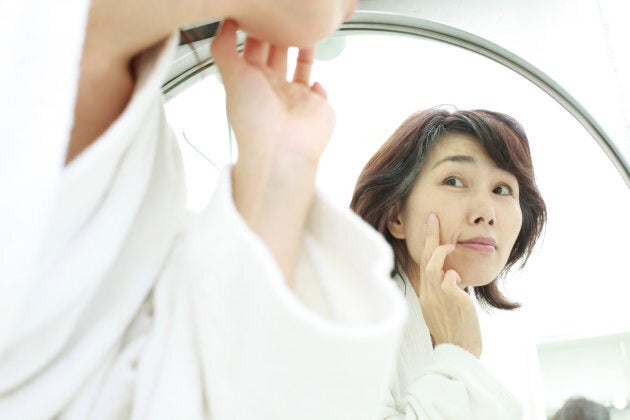From hormonal imbalances, to nutritional deficiencies, to psychological stress there are many internal factors that can trigger unwanted changes in how we feel and look. The 200 or so hormones that circulate through our body work in concert with each other like the many instruments in a symphony orchestra. And like the symphony, when even one falls out of tune -- an imbalanced and disharmonious sound ensues.

When it comes to our hormones, an imbalance in even one or two key hormones can leave us feeling out of sync and unwell. Women who are entering the early stages of peri-menopause can experience hormonal imbalances and may start to notice changes in their face, skin and body including acne, an expanding waistline and hair loss.
These common changes can arise because of an imbalance in female and male sex hormones. Early in peri-menopause, there is often an increase in estrogen with a secondary increase in circulating levels of free testosterone. The estrogen-free testosterone rise occurs because there is inter-conversion between these two vital hormones, largely in fat tissue, but also because the increased estrogen binds to carrier proteins in the blood replacing the bound testosterone and allowing it to be taken up in its target tissue and exert its effects. In women, these effects may include increased body hair, shedding of hair from the frontal hair line and crown, acne breakouts (often involving cysts along the jawline), increased underarm sweating and changes in body odour, and sometimes changes in sexual function with either increased or decreased libido.
From acne to hair loss, a combined inside-outside approach is recommended.
This picture of hormonal imbalance can be seen in early peri-menopause but also in women with conditions such as polycystic ovarian syndrome (PCOS) characterized by high estrogen levels, often absent ovulation and high androgens, as well as in metabolic syndrome, which is characterized by insulin resistance and inflammation.
A personalized approach to restoring hormone balance requires an in-depth understanding of the overlying situation as well as common related issues such as nutritional deficiencies and metabolic derangements.
Whether it's acne, hair loss or a body reboot -- here are some helpful tips to restore hormonal and metabolic balance.
Take an inside-outside approach
From acne to hair loss, a combined inside-outside approach is recommended, combining internal rebalancing treatments with topical therapies to target the concern directly.
Enhance estrogen metabolism
For women in early peri-menopause or experiencing irregular periods possibly associated with PCOS, high estrogen levels can be addressed by supporting the body's natural detoxification and elimination pathways. Cruciferous vegetables like broccoli, bok choy and Brussels sprouts contain nutrients shown to improve estrogen metabolism in pre-menopausal women. Ingredients like turmeric, omega 3 fatty acids, and dietary soluble fibre (i.e. glucomannon) can favour more complete estrogen inactivation and clearance.
Block androgen conversion
Testosterone is converted to dihydro-testosterone (DHT) a more potent hormone that can trigger hair loss and acne through its effects on the hair follicle and sweat gland, respectively. Saw palmetto has been shown to reduce this conversion, causing an effect analogous to medications like finasteride (Propecia), approved for us in hair loss in men.
Boost your nutrition
For hair and skin, the B vitamins are of paramount importance. B12 and Biotin are commonly used in the treatment of hair loss. Minerals such as iron can be low in women with regular cycles and can contribute to changes in skin, hair and weight.
Reboot your metabolism
Insulin resistance- a forerunner to diabetes- is often associated with the hormonal imbalances discussed. Insulin resistance on its own can cause changes in the skin. These include acne, hair loss as well as a tanning/brownish discoloration known as acanthosis nigricans and wart like growths on the skin folds of the neck and chest known as acrochordons. BY adopting a diabetic type Mediterranean diet and partaking in regular aerobic exercise, insulin resistance can be slowed down or reversed. A diet with little grains, minimal refined sugars, and mostly low glycemic index foods is recommended. Beyond the skin and hair benefits, normalizing insulin signaling can improve metabolism, weight and body shape, reduce risk of diabetes, normalize menstrual irregularities, and improve fertility.
These five steps can be shaped within a personalized treatment plan to precisely address the underlying hormonal, nutritional and metabolic imbalances helping you to reach your goals for health, body and beauty!
Dr. Jennifer Pearlman is a Women's Health, Hormone and Aging expert. She is medical director of PearlMD Rejuvenation in Toronto.
Follow HuffPost Canada Blogs on Facebook
Also on HuffPost:
